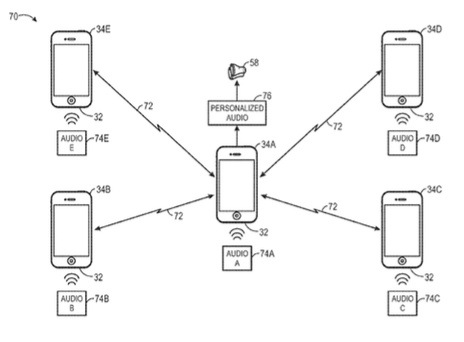An Apple patent (number 20120189140) for an audio sharing network has appeared at the U.S. Patent & Trademark Office. Systems, methods, and devices for sharing ambient audio via an audio-sharing network are provided.
By way of example, a system that receives shared audio from such an audio-sharing network may include a personal electronic device. The personal electronic device may join an audio-sharing network of other electronic devices and receive several audio streams from the audio-sharing network. Based at least partly on these audio streams, the personal electronic device may determine a digital user-personalized audio stream, outputting the digital user-personalized audio stream to a personal listening device.
By way of example, the personal electronic device may represent a personal computer, a portable media player, or a portable phone. The personal listening device may represent a speaker of the personal electronic device, a wireless hearing aid, a wireless cochlear implant, a wired hearing aid, a wireless headset, or a wired headset, to name only a few examples.
Here’s Apple’s background on the invention: “The present disclosure relates generally to providing an audio stream to a listening device and, more particularly, to providing a personalized ambient audio stream using ambient audio from an audio-sharing network.
“This section is intended to introduce the reader to various aspects of art that may be related to various aspects of the present techniques, which are described and/or claimed below. This discussion is believed to be helpful in providing the reader with background information to facilitate a better understanding of the various aspects of the present disclosure. Accordingly, it should be understood that these statements are to be read in this light, and not as admissions of prior art.
“In a variety of situations, many people may desire to hear conversations and lectures more clearly. Hearing impaired individuals, for instance, may face difficulties hearing without some amplification and accordingly may wear hearing aids. In general, hearing aids may obtain and amplify ambient audio using microphones in the hearing aids. In certain situations, such as a large group conversation or a lecture, relying on these microphones alone may not allow the hearing aid wearer to participate in the conversation or lecture, because the source of pertinent audio may be located far away or may be obscured by a variety of other nearby sounds.
“Various techniques have been developed to enable audio from other microphones to be provided directly to the hearing aids with or without using the microphones in the hearing aids. For example, loop-and-coil systems may transmit audio from a public address (PA) system to all loop-and-coil-equipped hearing aids within an area, and networkable hearing aids may share audio obtained from their respective microphones.
“These techniques may have several drawbacks. For example, loop-and-coil systems may provide the exact same audio stream to all hearing aids in the area and may require significant capital costs for installation and/or tuning by sound engineer, which may be cost prohibitive to some organizations. Existing networkable hearing aids also may provide essentially the same audio to all hearing aid wearers in such a network, may require additional network hardware, may be cumbersome to join, and/or may allow eavesdropping on conversations by distant devices.”
Gregory N. Hughes is the inventor.
Also appearing today at the U.S. Patent & Trademark Office are:
° Patent number 20120188245 for display resolution increase with mechanical actuation. Provided apparatuses and methods for increasing the pixel density of a digital display through mechanical actuation. In some embodiments, a display device is described having a processor configured to provide an image for display and a memory coupled to the processor. It involves the new Retina display MacBook Pro and doubtless other upcoming Macs with Retina displays. Edward Hyatt Craig is the inventor.
° Patent number 20120188255 for a framework for graphics animation and compositing operations. Ralph Brunner, John Harper and Peter N. Graffagnino are the inventors.
° Patent number 20120188371 is for stabilizing directional audio input from a moving microphone array. The inventors are Shaohai Chen, Phillip George Tamchina and Jae Han Lee.
° Patent number 20120188406 for systems and techniques for reducing power consumption in video image capture devices. In particular, in some embodiments, a computing system is provided that includes an image capture device and an application specific integrated circuit (ASIC) filter coupled to the image capture device. The ASIC filter includes an averaging circuit configured to provide an output representing an average value of a first set of values of a pixel grouping and an outlier determining circuit configured to determine if a value of a target pixel is outside a range of values for first set of values of the pixel grouping. A multiplexer is provided and configured to replace the value of the target pixel with the average value if the value of the target pixel is determined to be an outlier. Edward Craig Hyatt is the inventor.
° Patent number 20120188406 for coordinating sync points between a non-volatile memory and a file system. The inventors are Nir J. Wakrat, Daniel J. Post and Dominic Giampaolo.
° Patent number 20120188268 for a display color-correcting system. Gabriel G. Marcu and Wei Chen are the inventors.
° Patent number 20120190239 for an integrated noise reduction connector. Anna-Katrina Shedletsky is the inventor. An electrical connector comprising an insulative body, a plurality of pins carried by the body and a ferromagnetic element that rides on one of the plurality of the pins. The ferromagnetic element provides a low pass filter capability for signals transmitted over the one pin.
° Patent number 20120191694 for topic-based language models for an application search engine enable a user to search for an application based on the application’s function rather than title. To enable a search based on function, information is gathered and processed, including application names, descriptions and external information. Processing the information includes filtering the information, generating a topic model and supplementing the topic model with additional information. The inventors are Natalia Hernandez Gardiol and Catherine Anne Edwards.


